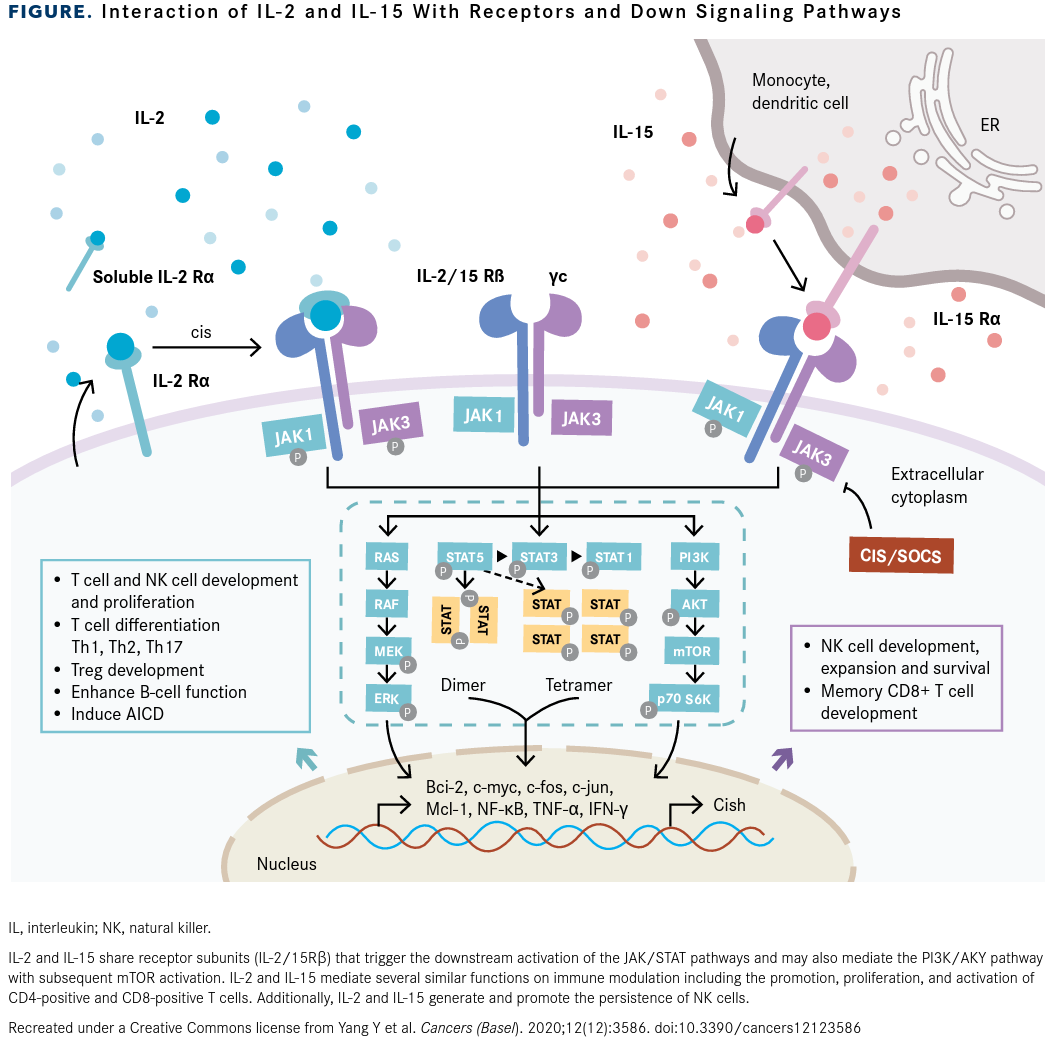Publication
Article
Oncology Live®
Superagonists Pull IL-15 Into Focus in Oncology Care
Author(s):
Following in the footsteps of the cytokine interleukin-2, IL-15 affords investigators similar qualities as a target without the associated toxicities of its immunotherapeutic predecessor.

Following in the footsteps of the cytokine interleukin (IL)-2, IL-15 affords investigators similar qualities as a target without the associated toxicities of its immunotherapeutic predecessor.1 Because IL-15 represents a potential potent immune modulator, leveraging its ability to activate effector T and natural killer (NK) cells may rely on the development of immune cytokines with additional antibodies to enhance antibody-dependent cellular cytotoxicity.2
IL-15 and IL-2 activate downstream JAK/ STAT signaling pathways through shared β and γ receptor subunits; however, distinctions between IL-2 and IL-15 become more evident in adaptive immune response and their role in the immunomodulation of T and NK cells in the tumor microenvironment (FIGURE).2 IL-15 has demonstrated similar receptor binding, biologic activity, and signaling as IL-2, but without the adverse effect (AE) profile, including the induction of severe capillary leak syndrome.1,2
FIGURE. Interaction of IL-2 and IL-15 With Receptors and Down Signaling Pathways

One of the shortcomings with IL-15, however, is the short half-life because of its small molecular size. Investigators sought to optimize IL-15 with the development of fusion proteins with IL-15Rα bound by flexible linkers that enhance the affinity for IL-15βγ.1,2 This circumvents the need for dendritic cells expressing the subunit receptors for IL-15 to be in proximity for maximum efficacy.1
Investigational superagonists have demonstrated preclinical effects in murine models including increased half-life from 7 to 20 hours, increased IL-15 potency, and serum stability, with detectability in patient serum up to 7 days after subcutaneous injection. Further, restricted tumor growth and improved median overall survival were also observed in breast and colon cancer tumors, with improved efficacy observed when combined with anti-CTLA or anti–PD-L1 therapies. In terms of hematologic models, when IL-15 was combined with anti-CD20 antibodies, NK cell responses were improved in murine B cell lymphomas.1
Applications Across Solid Tumors
Investigators have observed preclinical efficacy of IL-15–directed therapies in combination with other targeted therapies has paved the way for investigators to evaluate IL-15 superagonists in phase 1 and phase 2 trials.
N-803
N-803 (Anktiva) is a first-in-class IL-15 superagonist consisting of 3 key structural components: the cytokine (IL-15N72D), the cytokine fusion (IL-15Rα), and the antibody (IgG1 Fc). Specifically, the cytokine and antibody work in tandem to proliferate endogenous NK cells/CD8-positive T cells without inducing T-regulatory stimulation in the tumor microenvironment. Additionally, the IgG1 Fc has demonstrated the ability increase the agent’s half-life and increase honing to the CD16 receptors expressed on NK cells and macrophages.3
Bladder Cancer Sees Marked Results
Preliminary data from the phase 2 QUILT 3.055 trial (NCT03228667) demonstrated the tolerability of the IL-15 superagonist across multiple cohorts of patients who received N-803 in combination immune checkpoint inhibitors (ICIs) after prior treatment with ICIs.3 Specifically, among the 140 patients who received therapy, serious treatment-related AEs (TRAEs) were observed in 8% of patients, including respiratory failure in 1 patient that was grade 5 and attributed to N-803 and the ICI.3
Investigators also reported that compared with standard chemotherapy-containing regimens, the investigative approach had lower rates of AEs. In terms of efficacy, 49% of individuals on the trial had stable disease (SD), with 36% having SD more than 2 months and 16% having SD more than 6 months. Overall, 13 patients had a partial response to therapy.3
N-803 received a breakthrough therapy designation from the FDA in December 2019 for the treatment of patients with BCG-unresponsive non–muscle invasive bladder cancer following promising results from a phase 1/2 study (NCT02138734) of the agent in combination with BCG.4
Data from the ongoing phase 2/3 QUILT-3.032 trial (NCT03022825) of the combination have met the primary end point. In updated data from cohort A of the trial presented at the 2021 American Urological Association Annual Meeting, the complete response (CR) rate was 72% (95% CI, 61%-81%) among the 81 patients enrolled.5 Additionally, investigators reported that patients who had a response had a 58.6% (95% CI, 43.1%-71.2%) probability of maintaining a CR for at least 12 months. At a median follow-up of 20.4 months, the median duration of CR was 19.9 months (95% CI, 7.8–not reached). As of data cutoff of May 19, 2021, 30% of patients had a durable response at 18 months.5
Investigators aimed to curb the incidence of patients progressing to radical cystectomy. In the trial, 85% of patients were able to avoid cystectomy following administration of 50 mg of BCG plus 400 mg of intravesical N-803 weekly for 6 weeks. Of note, the patient population was heavily pretreated, with patients having received a median of 12 prior BCG instillations and a median of 5 prior transurethral resections of bladder tumors, as well as 42% of patients having received prior treatment with chemotherapy in addition to BCG.5
In terms of safety, the combination was well tolerated, with no grade 4/5 AEs. Two patients experienced grade 3 TRAEs (urinary tract infection and arthralgia). The most frequent grade 1/2 AEs were dysuria (22%), hematuria (16%), and pollakiuria (19%).5
Combinations Fuel Progress in Pancreatic Cancer
Pancreatic cancer is notoriously difficul to treat. Investigators in the phase 2 QUILT-88 trial (NCT04390399) are hoping to elicit the activation of a patient’s entire immune system with a unique combination of low-dose chemoradiation, cytokine-induced NK-cell and T-cell activation, and PD-L1–targeted high-affinity NK cell (t-haNK) infusion. The QUILT-88 trial leverages N-803 in combination with standard-of-care chemotherapy, aldoxorubicin hydrochloride (a type II DNA topoisomerase inhibitor), stereotactic body radiation therapy, and an off-the-shelf PD-L1 t-haNK.
The study protocol was designed to evaluate the treatment across 3 cohorts stratified by line of the therapy (first, second, and third or later), with a primary end point of progression-free survival. Data from the cohort of 61 patients who received therapy in the third or later line were presented at the 2022 American Society of Clinical Oncology Gastrointestinal Cancers Symposium.6
The median overall survival (OS) in the overall cohort was 5.8 months (95% CI, 3.9-6.9). For those who received treatment with the investigational combination in the third line, the median OS was 6.8 months (95% CI, 5.0-9.8), which investigators noted more than doubled the median OS vs historical standards after second-line therapies. TRAEs were uncommon and occurred in 8% of patients, with no treatment-related deaths reported. Additionally, investigators noted that all treatments were administered in an outpatient setting.6
Forward-Looking Prospects Include Lung and Breast Cancers
In patients with stage IIIB or IV non–small cell lung cancer (NSCLC), investigators hope to build on early synergistic effects of N-803 plus PD-1 inhibitors.3,7 Investigators of the phase 3 QUILT 2.023 trial (NCT03520686) will assess N-803 in combination with anti–PD-1 standard-of-care regimens pembrolizumab (Keytruda) with or without chemotherapy vs standard of care alone.8
Additionally, in October 2021, the combination of N-803 and pembrolizumab was selected for investigation as part of the Lung Cancer Master Protocol, or Lung-MAP.9 The precision medicine trial is a collaboration between the National Cancer Institute, Southwestern Oncology Group Cancer Research, Friends of Cancer Research, the Foundation for the National Institutes of Health, and private companies. Investigators of the phase 2/3 trial (NCT05096663) will evaluate the safety and efficacy of the investigative combination vs investigator’s choice of docetaxel, gemcitabine, or pemetrexed in combination with ramucirumab (Cyramza). The trial is expected to enroll approximately 478 patients with advanced NSCLC.10
Investigators also seek to capitalize on retreatment efficacy of N-803 by including it as a component of a chemoimmunotherapy backbone in the ongoing QUILT 3.058 trial (NCT04927884) in combination with sacituzumab govitecan-hziy (Trodelvy) for patients with triple-negative breast cancer who have had at least 2 prior therapies. N-803 will administered subcutaneously at 15 μg/kg with cyclophosphamide (25 mg) and PD-L1 t-haNK (approximately 2 × 109).11
References
- Knudsin KM, Hodge JW, Schlom J, Gameiro SR. Rationale for IL-15 superagonists in cancer immunotherapy. Expert Opin Biol Ther. 2020;20(7):705-709. doi:10.1080/14712598.2020. 1738379
- Yang Y, Lundqvist A. Immunomodulatory effects of IL-1 and IL-15; implications for cancer immunotherapy. Cancers (Basel). 2020;12(12):3586. doi:10.3390/cancers12123586
- Wrangle JM, Awad MM, Badin FB, et al. Preliminary data from QUILT 3.055: a phase 2 multicohort study of N803 (IL-15 superagonist) in combination with checkpoint inhibitors (CPI). J Clin Oncol. 2021;39(suppl 15):2596. doi:10.1200/JCO.2021.39.15_ suppl.2596
- ImmunityBio granted FDA breakthrough therapy designation for N-803 IL-15 superagonist in non-muscle invasive bladder cancer. News release. ImmunityBio. December 4, 2019. Accessed April 21, 2022. bit.ly/38XruU4
- Chamie K, Chang S, Gonzalgo M, et al. Phase 2/3 clinical results of IL-15RAFC superagonist N-803 with BCG in BCG-unresponsive non-muscle invasive bladder cancer (NMIBC) carcinoma in-situ (CIS) patients. J Urol. 2021;206(suppl 3):e120-e121. doi:10.1097/JU.0000000000001977.05
- Seery TE, Nangia CS, McKean HA, et al. Promising survival and disease control in third-line or greater metastatic or locally advanced pancreatic cancer patients following chemo-radiation and novel combination of aldoxorubicin, N-803 IL-15 superagonist, and PDL1- NK cell therapy. J Clin Oncol. 2022;40(suppl 4):582. doi:10.1200/JCO.2022.40.4_suppl.582
- Wrangle JM, Velcheti V, Patel MR, et al. ALT-803, an IL-15 superagonist, in combination with nivolumab in patients with metastatic non-small cell lung cancer: a non-randomised, open-label, phase 1b trial. Lancet Oncol. 2018;19(5):694-704. doi:10.1016/ S1470-2045(18)30148-7
- QUILT 2.023: a study of N-803 in combination with current standard of care vs standard of care as first-line treatment for patients with stage 3 or 4 NSCLC. ClinicalTrials.gov. Updated April 4, 2022. Accessed April 21, 2022. https://clinicaltrials.gov/ct2/ show/NCT03520686
- National Cancer Institute selects ImmunityBio’s N-803 IL-15 receptor agonist to combine with Keytruda in 700-site Lung-MAP clinical trial of a chemo-free therapy. News release. ImmunityBio. October 4, 2021. Accessed April 21, 2022. bit.ly/36z5Swq
- Testing the use of combination immunotherapy treatment (N-803 [ALT-803] plus pembrolizumab) against the usual treatment for advanced non-small cell lung cancer (a Lung-MAP treatment trial). ClinicalTrials.gov. Updated October 27, 2021. Accessed April 21, 2022. https://clinicaltrials.gov/ct2/show/ NCT05096663
- FDA authorizes ImmunityBio study of Anktiva and PD-L1 t-haNK to increase effectiveness of Trodelvy in triple-negative breast cancer. News release. ImmunityBio. June 15, 2021. Accessed April 21, 2022. bwnews.pr/3v5IekS




























%20(2)%201-Recovered-Recovered-Recovered-Recovered-Recovered-Recovered-Recovered-Recovered-Recovered-Recovered-Recovered-Recovered-Recovered-Recovered-Recovered-Recovered-Recovered.jpg?fit=crop&auto=format)
%20(2)%201-Recovered-Recovered-Recovered-Recovered-Recovered-Recovered-Recovered-Recovered-Recovered-Recovered-Recovered-Recovered-Recovered-Recovered-Recovered-Recovered-Recovered.jpg?fit=crop&auto=format)
